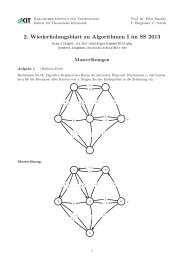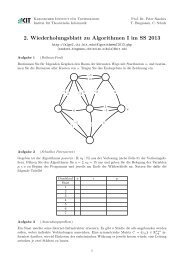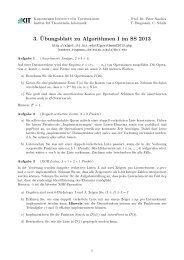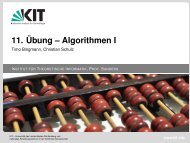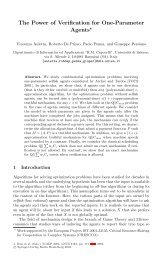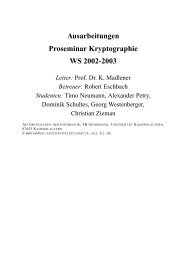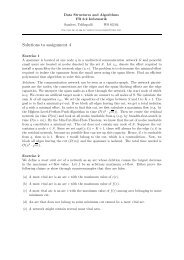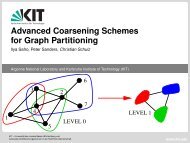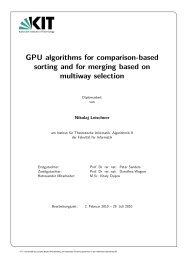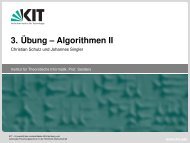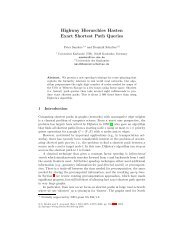Stxxl : Standard Template Library for XXL Data Sets - Max-Planck ...
Stxxl : Standard Template Library for XXL Data Sets - Max-Planck ...
Stxxl : Standard Template Library for XXL Data Sets - Max-Planck ...
Create successful ePaper yourself
Turn your PDF publications into a flip-book with our unique Google optimized e-Paper software.
Listing 4: Generating a random graph using the STL-user layer.<br />
1 stxxl : : vector ExtEdgeVec (10000000000ULL ) ;<br />
2 std : : generate (ExtEdgeVec .begin () ,ExtEdgeVec .end () ,random_edge ( ) ) ;<br />
3 stxxl : : sort (ExtEdgeVec .begin () ,ExtEdgeVec .end () ,edge_cmp () ,<br />
4 512∗1024∗1024);<br />
5 stxxl : : vector::iterator NewEnd =<br />
6 std : : unique (ExtEdgeVec .begin () ,ExtEdgeVec .end ( ) ) ;<br />
7 ExtEdgeVec .resize (NewEnd − ExtEdgeVec .begin ( ) ) ;<br />
STL is used). In the next line the <strong>Stxxl</strong> external memory sorter sorts randomly generated edges<br />
using 512 megabytes of internal memory. The lexicographical order is defined by functor my cmp,<br />
stxxl::sort also requires the comparison functor to provide upper and lower bounds <strong>for</strong> the<br />
elements being sorted. Line 6 deletes duplicate edges in the external memory vector with the<br />
help of the STL unique algorithm. The NewEnd vector iterator points to the right boundary of<br />
the range without duplicates. Finally (Line 7), we chop the vector at the NewEnd boundary. Now<br />
we count the number of I/Os per<strong>for</strong>med by this example: external vector construction takes no<br />
I/Os; filling with random values requires a scan — N/DB I/Os; sorting will take 4N/DB I/Os;<br />
duplicate removal needs no more than 2N/DB I/Os; chopping a vector is I/O free. The total<br />
number of I/Os is 7N/DB.<br />
2.4 Streaming Layer<br />
The streaming layer provides a framework <strong>for</strong> pipelined processing of large sequences. Many<br />
external memory algorithms implemented with the <strong>Stxxl</strong> streaming layer save a factor at least<br />
two in I/Os. The pipelined processing technique is well known in the database world [33]. To<br />
the best of our knowledge we are the first who apply this method systematically in the domain<br />
of external memory algorithms. We introduce it in the context of an external memory software<br />
library.<br />
Usually the interface of an external memory algorithm assumes that it reads the input from<br />
external memory container(s) and writes output in external memory container(s). The idea of<br />
pipelining is to equip the external memory algorithms with a new interface that allows them to<br />
feed the output as a data stream directly to the algorithm that consumes the output, rather than<br />
writing it to external memory. Logically, the input of an external memory algorithm does not<br />
have to reside in external memory, it could be rather a data stream produced by another external<br />
memory algorithm.<br />
Many external memory algorithms can be viewed as a data flow through a directed acyclic<br />
graph G = (V = F ∪ S ∪ R, E). The file nodes F represent physical data sources and data sinks,<br />
which are stored on disks (e.g. in the external memory containers of STL-user layer). A file node<br />
outputs or/and reads one stream of elements. The streaming nodes S read zero, one or several<br />
streams and output zero, one or several new streams. Streaming nodes are equivalent to scan<br />
operations in non-pipelined external memory algorithms. The difference is that non-pipelined<br />
conventional scanning needs a linear number of I/Os, whereas streaming nodes usually do not<br />
per<strong>for</strong>m any I/O, unless a node needs to access external memory data structures (stacks, priority<br />
queues, etc.). The sorting nodes R read a stream and output it in a sorted order. Edges E in<br />
the graph G denote the directions of data flow between nodes. The question “When a pipelined<br />
execution of the computations in a data flow graph G is possible in an I/O-efficient way?” is<br />
analyzed in [15].<br />
In <strong>Stxxl</strong>, all data flow node implementations have an <strong>Stxxl</strong> stream interface, which is similar<br />
10



